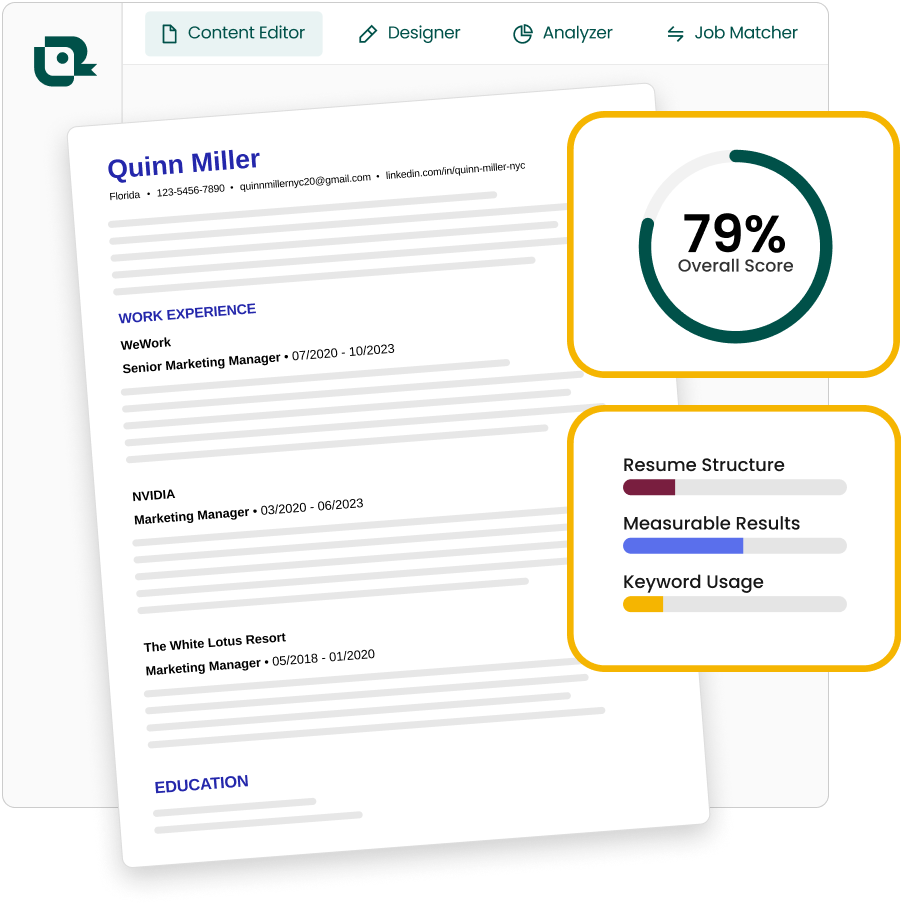5 key takeaways
- A resume is a short, targeted document used for most private-sector jobs.
- A CV is a full record of your academic and professional background, often used in education, research, or public roles.
- Resumes are usually one to three pages. CVs can be longer and grow as your experience builds.
- In the US, resumes and CVs are different. In many other countries, “CV” is the standard term and may mean the same thing that “resume” means in the US.
- Choose the format based on your role, region, and how you want to present your experience.
Ever seen a job description asking for a CV but haven’t been sure if that means a resume or something more detailed? Or gone to apply for an international role and have had no idea which one to send?
You’re not alone.
CVs and resumes often get spoken about like they’re the same thing, but they aren’t always interchangeable (despite what you might see on LinkedIn!). Sometimes “CV” means a detailed professional and academic history. Other times, “CV” just means “a type of resume,” depending on what you’re applying for and where.
This guide clears up the CV vs. resume confusion. You’ll learn what sets them apart, when to use each, and how to make your professional experience look great in either format.
CV vs. resume: Quick comparison
What is a resume?
A resume is a concise, targeted document—usually one to two pages—meant for quick review. It’s not a full career history. Rather, it highlights the experience most relevant to the exact role you’re applying for.
Strong resumes focus on results, using clear, measurable details to show what you accomplished, not just what you were responsible for. That’s why resume work experience sections include bullet points that highlight specific achievements, like:
- “Reduced patient readmission rates by 22% through improved discharge planning and patient education” (for a nursing role)
- “Redesigned mobile app UI, resulting in a 40% increase in user retention over 3 months” (for a user experience role)
- “Launched a new B2B platform feature that increased upsell revenue by $500K in Q2” (for a product management role)
These details turn your resume from a task list into proof of impact, so hiring teams can clearly see the value you could bring to their organization.
At Teal, we’ve reviewed thousands of resumes across different industries. The strongest ones focus on outcomes that show value, not just responsibilities.
Like Teal’s CEO, David Fano, says:
“Your resume isn’t just a highlight reel. It’s a marketing document. Its #1 goal? To get you to the next step: the interview.”
What is a CV (curriculum vitae)?
Short for curriculum vitae (Latin for “course of life”), a CV lists the full lineup of your academic and professional achievements. It details your degrees, fellowships, research projects, published work, courses taught, speaking engagements, and roles in academic or professional groups.
You’ll typically use one when applying to academic, research, medical, or certain international roles.
Unlike resumes, CVs are typically not tailored to specific roles. Instead, they’re designed to document the full scope of your professional journey, often growing over time as your work evolves.
But it’s not always so straightforward. Something that’s really confusing is that, in some places, “CV” means the same thing (or close to the same thing) as “resume.” Let’s take a closer look at the differences between these terms across regions.
Regional differences between a CV and a resume
When applying to jobs internationally, it’s smart to understand how the terms “CV” and “resume” are used in different parts of the world. While they often mean different things in the US, some countries treat them as interchangeable or use the term “CV” regardless of the format.
Here’s a quick breakdown:
United States
- There’s a clear distinction between both terms.
- A resume is the standard for most jobs, especially in business, tech, or marketing.
- CVs are used mainly for academic, scientific, and research positions where applicants must demonstrate their full career history.
If you're applying to federal jobs, you'll need a resume that reads more like a CV. The USDA recommends including full job duties, accomplishments, and even hours worked per week to meet eligibility criteria.
United Kingdom
- “CV” is the default term, even for roles that would require a resume in the US. (See, for instance, how the National Career Services uses this term.) When UK employers ask for a "CV," they’re typically referring to a shorter document that’s similar in purpose and length to a US-style resume.
- Employers may expect more detail, depending on the role or industry.
European Union
- “CV” is also the standard term, and it typically refers to a short, job-focused document (usually 1-3 pages), not a long academic CV.
- The Europass format is sometimes recommended for consistency, especially in public or cross-border applications.
- The term “resume” is rare and sometimes unfamiliar in hiring contexts.
Asia (e.g., India, China, Japan)
- CV and resume are often used interchangeably by employers, though some government agencies distinguish between them (see, for example, how the Singapore Government Agency distinguishes between them).
- That said, expectations can vary by region and industry, so always double-check the preferred format in the job listing.
Australia and New Zealand
- The terms “CV” and “resume” are often used interchangeably in both countries, especially for most professional job applications.
- Both terms usually refer to a concise, targeted document (typically 1-3 pages) that highlights relevant experience and skills—similar to a US-style resume. (See Study Australia’s guide on resumes.)
- In New Zealand, a more comprehensive, multi-page CV (akin to the US definition) may still be expected for academic, medical, research, or executive-level roles.
- Always check the job listing to confirm the expected format and level of detail.
When to use a CV vs. a resume
Not sure which one to send? Here’s a straightforward breakdown to help you choose the right format for your application:
Use a resume when applying to:
- Jobs in the private sector, meaning companies that operate for profit, including startups, corporations, agencies, and consultancies
- Jobs in countries where the term “CV” refers to a shorter, resume-style document, such as the UK, EU, Australia, and certain parts of Asia or Africa
- Roles in business, tech, marketing, sales, finance, HR, design, operations, and related fields
- Employers based in the US or Canada
- Positions that ask for a tailored, concise summary of relevant experience
Use a CV when applying to:
- Academic roles (e.g., professor, lecturer, researcher)
- Medical or scientific positions that require detailed credentials
- PhD programs, graduate school, fellowships, or research grants
- Public-sector or government roles outside the US and Canada
- Applications that require a complete record of your education, research, publications, and professional history
We’ve seen this decision confuse job seekers, especially when they’re shifting industries or applying globally. Focus on what the job post asks for and which format helps your experience stand out.
Can I use the same information in my CV and resume?
Yes, you can use the same core information in your CV and your resume. But while the facts stay the same, the focus should shift.
In a resume, you’re curating. You highlight what’s most relevant to the role and cut anything that doesn’t support your application or show your impact. It’s highly focused on measurable outcomes, e.g., “Increased customer retention by 25% in under a year” and “Launched a cross-functional onboarding program adopted in five regions.”
In a CV, you’re laying everything out. The goal is completeness, especially for academic or research opportunities. That means including your full education history, publications, conference presentations, teaching roles, grants, and professional service.
Resume vs. CV: Structure example
Let’s say you’re applying for a senior data analyst position. You have a relevant degree, several years of experience, and a mix of academic and industry work. The content stays the same, but the way you frame it depends on what opportunity you’re applying for.
Here’s how that might look, side by side:
Framing your experience: CV vs. resume
A CV and a resume aren’t just different formats, they serve different purposes. One gives a full account of your academic and professional background. The other zeroes in on the experience that’s most relevant to a specific role.
If you’re applying across industries, regions, or career paths, it’s smart to have both. A resume helps you tailor your strengths to the job at hand. A CV gives a broader view and is sometimes required.
There’s no universal standard. What matters is choosing the format that highlights your experience in the right way. That might mean reorganizing your education to put skills first, or reshaping academic work into bullet points that show real impact.
Your experience stays the same. But how do you frame it? That can change everything.
Ready to put your format to work? Use Teal’s Resume Builder to craft a resume that fits your goals, whether it’s academic, professional, or something in between.
Frequently Asked Questions
Is a CV just a longer resume?
No, a CV isn’t just a longer resume. A CV is a distinct format that provides a comprehensive overview of your academic and professional history. A resume is a shorter, tailored document focused on the experience most relevant to a specific job.
Do I need both a resume and a CV?
No, you don’t need both a resume and a CV in most cases, but having both can be helpful. Most job seekers only need a resume, unless they’re applying across industries or countries or to roles in academia, research, medicine, or government.
Can I use the same format for my CV and resume?
No, you shouldn’t use the same format for your CV and resume. A resume is concise and tailored to each job, emphasizing transferable skills and impact. A CV is longer, more structured, and designed to show the full scope of your career.
Which is better, a CV or a resume?
Whether a CV or resume is better depends on the job. Use a resume for most private-sector roles where you need to tailor your experience. Use a CV when applying to academic, research, or government positions that need a full career history. If an employer requests one over the other, heed their request, and always consider regional terminology and expectations, which can vary by country.
CV vs. Resume vs. Cover Letter: What’s the difference?
A resume highlights your most relevant experience. A CV gives a full record of your academic and professional history (though the term “CV” is sometimes used to mean the same thing as “resume”). A cover letter adds context, explaining why you're a good fit and what excites you about the role.





.jpg)


